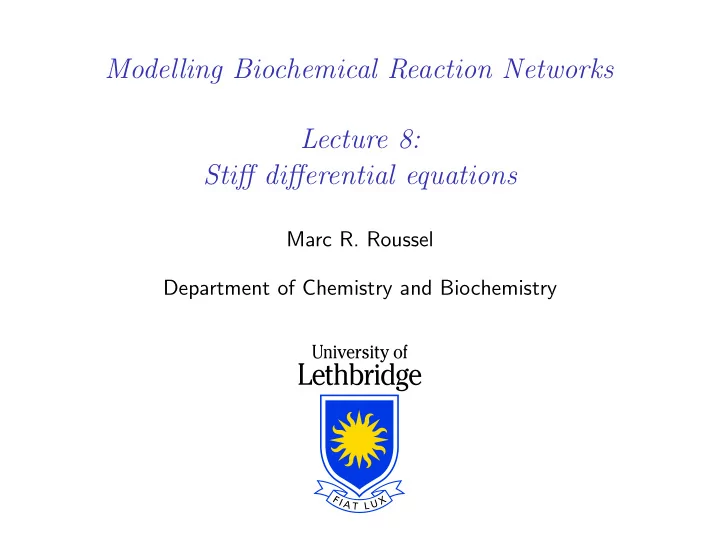

Modelling Biochemical Reaction Networks Lecture 8: Stiff differential equations Marc R. Roussel Department of Chemistry and Biochemistry
Michaelis-Menten kinetics revisited k 1 k − 2 − − E + S − − C − − → E + P ⇀ ↽ k − 1 ◮ Typical values of rate constants and concentrations: k 1 = 10 7 M − 1 s − 1 ≡ 10 ( µ M) − 1 s − 1 k − 1 = 100 s − 1 k − 2 = 100 s − 1 E 0 = 1 µ M ◮ From our scaling analysis (lecture 4), we picked out the slow t = ( k 1 E 0 ) − 1 = 0 . 1 s. time scale ˜ The product is formed on a fast time scale t = ( k − 2 ) − 1 = 0 . 01 s. ¯
Stiff equations Vastly different time scales are responsible for ◮ validity of steady-state approximation ◮ difficulties with numerical integration
Implicit Euler method ◮ Solve the ODE d x dt = f ( x , t ) using the approximation x i +1 − x i = f ( x i +1 , t i +1 ) (1) ∆ t ◮ Note that f is evaluated at the unknown forward point. = ⇒ implicit method (Methods like the Euler and Runge-Kutta methods that only require function evaluations and not the solution of an equation are called explicit.) ◮ Equation 1 has to be solved for x i +1 , usually using some kind of iterative numerical method.
Comparison of the explicit and implicit Euler methods Model considered: k 1 k 2 A − → B − → dA dt = − k 1 A A (0) = A 0 dB dt = k 1 A − k 2 B B (0) = 0 ◮ In real chemical systems, it is not unusual for k 1 and k 2 to differ by several orders of magnitude.
Comparison of the explicit and implicit Euler methods Explicit Euler method a i +1 = a i − k 1 a i ∆ t = a i (1 − k 1 ∆ t ) b i +1 = b i + ∆ t ( k 1 a i − k 2 b i ) = b i (1 − k 2 ∆ t ) + k 1 a i ∆ t ◮ If 1 − k 1 ∆ t < 0 then a i +1 is of the opposite sign to a i . ◮ a i eventually becomes small. Then b i +1 changes sign if 1 − k 2 ∆ t < 0. ◮ We must therefore have both ∆ t < ( k 1 ) − 1 and ∆ t < ( k 2 ) − 1 . ◮ If (say) k 2 ≪ k 1 , then we have to take tiny step sizes, even though they aren’t required to get the A component of the solution.
Comparison of the explicit and implicit Euler methods Implicit Euler method a i a i +1 − a i = − k 1 a i +1 ∆ t ⇒ a i +1 = 1 + k 1 ∆ t b i +1 − b i = ∆ t ( k 1 a i +1 − k 2 b i +1 ) ⇒ b i +1 = b i + k 1 a i +1 ∆ t 1 + k 2 ∆ t b i + k 1 a i ∆ t 1+ k 1 ∆ t = 1 + k 2 ∆ t ◮ Possibility of negative concentrations eliminated (model dependent) ◮ Can take large steps of size similar to the slow time scale ◮ Large time steps lead to a decrease in accuracy, but no loss of stability
Other methods for integrating stiff equations ◮ There are a variety of methods for integrating stiff equations. Almost all of them are implicit methods. ◮ Most methods for integrating stiff equations, as well as many methods for non-stiff equations, vary the step size to maintain accuracy through regions where some variables are changing rapidly. ◮ Typical error control: | x ( t ) − x i | ≤ η | x i | + ǫ where x ( t ) is the true solution, η is the relative tolerance, and ǫ is the relative tolerance. The magnitude of | x ( t ) − x i | is estimated, since we don’t know the true solution, often by using trial refinements of the step size.
Concluding comments on numerical integration ◮ Don’t be afraid to experiment with different numerical methods and step sizes. ◮ I usually like to check my results by doing two calculations, with the step size in the second being half as large as in the first. If the two give essentially the same results, you can have some confidence in the results. ◮ For biochemical systems, I almost always use a method for stiff systems. In xppaut , the stiff integrators are Gear , CVODE , Rosen , and Stiff . I find that Stiff works really well for a variety of problems, but sometimes one of the others works better.
Recommend
More recommend